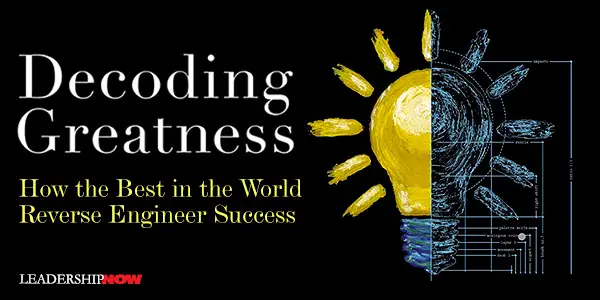 |
 |
07.12.21

How the Best in the World Reverse Engineer Success
REVERSE ENGINEERING is systematically taking things apart to discover how and why they work. It is routinely done in tech—Steve Jobs and Bill Gates copied and improved on Xerox Palo Alto Research Center’s Alto computer to bring us the Macintosh and windows—but it is also done in with the best speeches, art, movies, music, and literature to discover what makes them so successful. Just as both “Jobs and Gates reaped enormous benefit from studying the works of their contemporaries, extracting crucial insights, and applying those lessons to develop new products, says Ron Friedman in Decoding Greatness, you can too. To reverse engineer is to look beyond what is evident on the surface and find a hidden structure—one that reveals both how an object was designed and, more important, how it can be re-created. One method employed by elite performers like Judd Apatow, Steven King, F. Scott Fitzgerald, Jack London is copywork. “It involves studying an exceptional piece of writing, setting it aside, and then re-creating it word for word from memory, later comparing your version to the original. Many of the painters we now celebrate as creative geniuses devoted a significant portion of their careers to copywork. Claude Monet, Pablo Picasso, Mary Cassatt, Paul Gauguin, and Paul Cézanne all developed their skills by copying the works of the French painter Eugène Delacroix. Delacroix himself spent years copying the Renaissance artists he grew up admiring. Why do it? Reproducing a piece demands that he or she pay careful attention to the organizational decisions and stylistic tendencies reflected in an original work. It is an exercise that enables novices to relive the creative journey and invite them to compare their instinctive inclinations against the choices of a master. Friedman adds that “copying challenges our default approach” and “it opens us up to novel ways of thinking, prompting us to find creative opportunities buried within our own work.” From science-based insights and the lives of a wide range of elite performers, Friedman has gathered ten lessons we can apply to our work. His findings are interesting and sometimes counterintuitive. Here are the ten lessons with key takeaways: #1 Become A Collector The first step to achieving mastery is recognizing mastery in others. #2 Spot the Difference To learn from your favorite examples, you need to pinpoint what makes them unique. What’s different? By comparing the stellar to the average, you can pinpoint key ingredients that give a work its flavor and identify particular elements that can be incorporated or evolved elsewhere. #3 Think in Blueprints Nearly every example you admire was developed using a blueprint. By working backward and crafting a blueprint, you will find patterns that demystify complex works. #4 Don’t Mimic, Evolve Copying someone else’s wildly successful formula wholesale is the fastest route to being perceived as unoriginal while contributing to a genre’s demise. #5 Embrace the Vision-Ability Gap Studying the masters comes with a price: it raises the bar on the performance you deem necessary to be successful. Don’t give up. Instead, celebrate the fact that we can sense when improvements are needed. That instinct is indispensable to achieving greatness. #6 Keep Score Selectively The first step to improving at anything begins with relentlessly keeping score. #7 Take the Risk Out of Risk-Taking Find stretch opportunities that don’t impose a high cost to failure. #8 Distrust Comfort We don’t grow when we are enjoying ourselves—we learn best when we are challenged, struggling, and occasionally failing. #9 Harness the Future and the Past Repetition and feedback can help you elevate your performance, especially when used to target your weaknesses. But if that’s the only practice you’re getting, chances are you’re only operating at a fraction of your potential. #10 Ask Wisely Experts rarely make great instructors. Studies show that the better we perform a task, the worse we are at communicating how we managed to do it. Knowing something makes it impossible to imagine not knowing it. What is interesting, too, is that we might think that the totally novel product or approach would win over your audience. But the most successful people develop successful formulas that “leverage (rather than violate) an audience’s expectations.” In a majority of cases, copying or over-relying on established recipes is a losing strategy that rarely results in memorable outcomes. Just as dangerous, however, is ignoring proven formulas altogether and overwhelming audiences with a flood of originality. People don’t crave novelty as much as we would think. Organizations routinely reject very creative ideas. “outright mimicry leads us nowhere. Absolute novelty is met with scorn.” Avoid both extremes. It’s better to use a proven formula and adding your own unique twist. 
Posted by Michael McKinney at 03:10 PM
|
BUILD YOUR KNOWLEDGE
 

How to Do Your Start-Up Right STRAIGHT TALK FOR START-UPS 
Grow Your Leadership Skills NEW AND UPCOMING LEADERSHIP BOOKS 
Leadership Minute BITE-SIZE CONCEPTS YOU CAN CHEW ON 
Classic Leadership Books BOOKS TO READ BEFORE YOU LEAD |